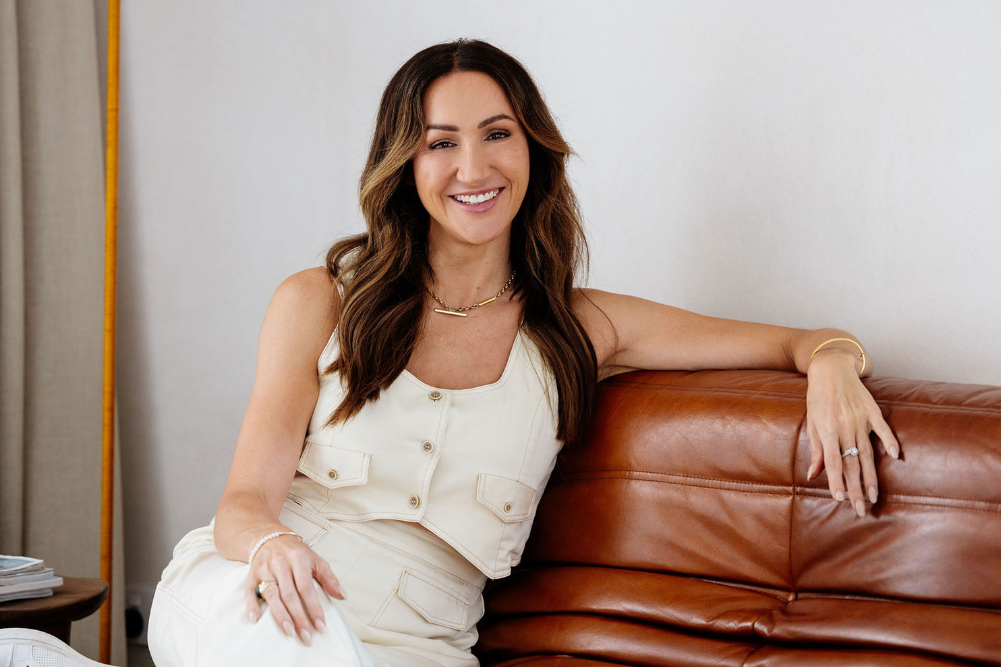Get to know David Frenkiel and Luise Vindahl from Green Kitchen Stories
Every kitchen has its own story, with the kitchen that Swedish David Frenkiel and Danish Luise Vindahl share with their three children in Stockholm no exception. These two peas in a pod are behind Green Kitchen Stories, an award-winning food blog that pioneered the Scandinavian vegetarian food scene more than a decade ago by offering a seasonal, healthy and modern take on vegie recipes created in their very own green kitchen.
Green Kitchen Stories began as a blog in 2009 and has evolved into a multimedia brand encompassing five cookbooks (The Green Kitchen, Green Kitchen Travels, Green Kitchen Smoothies, Green Kitchen at Home and Little Green Kitchen), an app and quite the Instagram following between their two accounts — @gkstories (394k followers) and @luisegreenkitchenstories (214k followers). Across these channels, Frenkiel and Vindahl share easy, delicious and nutritious vegetarian family recipes and travel tips from their adventures with their brood. From shooting inspiring flat-lay food photography to capturing joyous moments shared as a family, the visual storytelling of Green Kitchen Stories is just as rich as the recipes themselves.
“If you tell a story about a recipe it’s not usually just the ingredients. It’s always who taught you it. I mean recipes have more meaning than just the ingredients, and that’s what we try to tell.”
I meet the couple on FaceTime as morning light streams through their home in Stockholm, Sweden, and birds are chirping in the background. They have just dropped off their three children — Elsa (10), Isac (6) and Noah (3) — at school. An average day for the couple varies from day to day, Frenkiel explains, but is built around their roles as parents. “We have the routine around the kids — dropping them off and picking them up, having breakfast together and all that,” with Vindahl adding, “and we have so many different projects. We have projects mostly with each other, a few projects without each other, and a lot of things with the kids. And we still don’t have an assistant or a nanny,” she says with a laugh, “so we try to put all work in between 9am and 4pm. It can be developing things for the website, for Instagram, or just in Green Kitchen.” From finishing each other’s sentences in their sweet Scandi accents to the laughter they share with each other, it’s hard not to be captivated by the warmth of these partners in work and in life.
The couple’s love story began more than a decade ago when they met in Rome. Frenkiel was a self-proclaimed “unhealthy vegetarian” and Vindahl a “healthy carnivore”, which led them to cultivate a new way of cooking and eating together. In 2014 Frenkiel proposed to Vindahl in the back of a campervan in New Zealand, but they didn’t get married until November 2017; they shared the experience in a rustic Swedish greenhouse on a chilly November’s day not only with their closest friends and family, but also their children.
Frenkiel (39) hails from Sweden and has been a vegetarian for more than 20 years. He’s a graphic designer and photographer by trade and worked as a magazine art director for 10 years before transitioning into being a full-time cookbook (and app) author, photographer and recipe developer. Vindahl (35) is originally from Denmark and has a background in nutritional therapy, which has no doubt influenced the “green” element of their recipes. “I think we had our differences when we met each other and we realised that we didn’t have the exact same approach to food and to health,” Frenkiel reflects. “Luise was much more healthier,” he continues, laughing, “and into more diverse eating than I was.” But they used their differences to their advantage and paved a new path together. “We are both very open-minded and spontaneous and positive, and I think that definitely helps,” Vindahl adds.
From a hobby to a career
As their family has grown, so too has their green kitchen. “Back then [at the beginning] it was just us trying to develop a way of eating together, and writing about it,” Vindahl explains. “And living together,” Frenkiel adds as they both laugh. “Now we have our whole family to feed,” Vindahl continues. “It has been a natural evolution. And it hasn’t been a really thought-through plan all the time,” Frenkiel reflects. “In the beginning this wasn’t even our job — it was just a blog.”
The transition from Green Kitchen Stories as a passion project to a business happened during their first book when Frenkiel was still working in magazine publishing. “It was when we signed the second book that we realised …” “We had to decide,” Vindahl says, finishing Frenkiel’s sentence. “It was quite hard to have several focuses,” Frenkiel continues. “And as this blogging business took up more and more time — answering comments, figuring out recipes — and navigating parenting, we realised that we had to focus on one thing,” with that focus being their green kitchen.
Embracing flexibility and creativity
When it comes to their children and food — which plays an integral role in Green Kitchen Stories — “they like most things,” Vindahl explains, but that may be due to the fact that the family has a rule of only cooking one meal for everyone. “And then we usually have different things to choose from in one meal. We don’t force them to eat anything they don’t like, but we encourage them to try everything on the table. And it changes all the time. We just had a long period where they only wanted to eat egg whites and not the yolk.” “They eat something one day and then all of a sudden they hate it,” Frenkiel continues. “Luise made a spinach quiche yesterday, and they haven’t been eating spinach for quite a while. They’ve been like, ‘that’s disgusting’, and now two out of three loved it. And the third one, he didn’t like it …” “He liked the crust,” Vindahl interjects, laughing.
These humble parents understand the universal struggle of getting children to eat vegetables, and one of their ways around this predicament is through a healthy game of wrestling. “If you eat your greens, you’re gonna get strong,” Frenkiel states, explaining that this is what he advises their children when they’re reluctant to eat their vegies. They have a family ritual of wrestling on the couch after dinner; “I always say, ‘Now you don’t have to eat your spinach, I can take that if you don’t want it. And then I’m gonna beat you when we have our wrestling’,” Frenkiel says with a smile. “They look at me and they quickly shove it in. I think they understand that’s not how the physical body works but still they feel strong.” This technique worked yesterday with their youngest son, Noah.
“The kids have a lot to say in what we eat,” Vindahl explains, in everything from choosing what to have for dinner to chopping up ingredients, highlighting the flexibility and creativity they embrace in family cooking. “And if they’re not helping out actively, allowing them to express an opinion or to taste and guide them a bit is also really helpful, just to make them more engaged,” adds Frenkiel. Their children are integrated into the food experience, which shines through in their visuals on Instagram and in their cookbooks. Not only are Vindahl and Frenkiel open-minded as a couple, they also embody this philosophy as a family. “I think that’s what we have in common — Luise and I — we have this openness. I’m not sure you can force that. It’s not something that we have talked about and discussed. I think it’s more just how it’s turned out,” Frenkiel reflects.
Food enriched with story
“The food we cook — all the food — it comes with a story,” Frenkiel explains. “Not only for us, but for most people. If you tell a story about a recipe it’s not usually just the ingredients. It’s always who taught you it. I mean recipes have more meaning than just the ingredients, and that’s what we try to tell. So that’s why our recipes on the blog and in the books have been very personal, because we want to bring more to the table, or to the book, than just the ingredients and how to combine them. It’s also very emotional.”
Staying relevant to their audience while staying true to their values has been an organic process expressed through their recipe storytelling; a co-creation the whole family partakes in. “All the food comes with a story,” says Frenkiel. “When Elsa was younger, she was very simple to feed. She liked a lot of food and was open to testing. I remember when she was a toddler she was always leaning her head backwards and saying, ‘mmmmmmm’, every time we gave her something to eat!” he laughs. “We wrote our first book [The Green Kitchen] then and thought how easy it was to have kids. As she grew older, and we had Isac, our second kid, we realised it is not always as simple — not all kids just like food and want to try it,” which is how their Green Kitchen story began to grow. “That’s when we started trying to figure out how to get them to eat more vegetables, and realised they loved pancakes. Pancakes are our family dish; we do it almost weekly. They’re so quick and simple and when it comes to simple recipes that they love, finding ways to get vegetables into those dishes was suddenly what we had to figure out.” This story was the catalyst for creating one of their most popular recipes in Green Kitchen at Home: Banana and Spinach Pancakes.
“Our recipes on the blog and in the books have been very personal, because we want to bring more to the table, or to the book, than just the ingredients and how to combine them. It’s also very emotional.”
Not only are their recipes rich in story, they’re also steeped in history. “I have this special love for porridge,” says Frenkiel. “It’s like a warming feeling in the morning that comes back to my grandparents. When I was a kid I spent summers with my grandparents. My grandfather — he was a farmer — he woke up really early to feed the animals. And as we woke up, he was always in the kitchen making porridge. I still hear that sound of a wooden spoon stirring the pot whenever I’m making porridge; I think we still have my grandfather’s spoon. It means so much more than just the porridge, to me, and that’s what I want to bring forward to our kids. It’s not only food, but also history that I’m cooking.” One quick glance at their Instagram feeds or cookbooks shows a chic Scandinavian kitchen with a cosy fireplace that would no doubt add some hygge to Frenkiel’s morning porridge ritual.
This in-depth form of storytelling wasn’t always part of the plan for Green Kitchen Stories, however. “When we started, we didn’t have any idea of what it would become,” Frenkiel explains, with Vindahl adding, “It was also a very undiscovered area 10 years ago, and it was just the right time for developing a new way of eating vegetarian food.” They even attempted writing in three different languages (Danish, Swedish and English) but that, understandably, became too much. “By choosing English we thought we could find a few people around the world who share the same interests in this as us, and then we realised it was more than a few,” Frenkiel explains. “Plant-based eating has peaked and it has been driven by different things, and it keeps changing. And I think since we haven’t jumped on any of those trends it’s helped us to stay in the conversation.”
Growing the green kitchen
It comes as no surprise that another Green Kitchen Stories book is on the cards, but the intention behind this new cookbook is still in question. “We have an offer for another cookbook, and I think we’re going to do it, we just want to do it for the right reason,” Frenkiel says. “Writing cookbooks is super fun and quite hard. I mean you get lost in the process of writing a cookbook — when you’re deep into recipe testing, it gets mushy. And we don’t want to feel like we’re just making another cookbook … we want to make it with a purpose, and feel like it really means something to us, and to the people reading it. So we’re still in that process.”
What comes as more of a surprise, however, is learning about their other projects. From Frenkiel co-owning a falafel restaurant in Stockholm — Fafelle — with a few of his friends, to the couple launching a vegan supplement line with a Danish brand, their green kitchen is definitely evolving. Despite Vindahl and Frenkiel having different strengths, they meet each other with creativity. “We have different talents, but when it comes to creativity we’re both quite similar. But I am really hard to please,” laughs Frenkiel. “Recipes, books … If I would do things on my own, we would never finish. Luise is really good at making things happen, so it’s good that we have different traits and talents, but together I think that’s been one of the keys as to why we’ve been fairly successful in what we’ve done, because we’ve combined our differences into something good.” That “something good” has turned into a world-renowned food blog and a slew of cookbooks that are inspiring families around the world to write their very own green kitchen stories.








